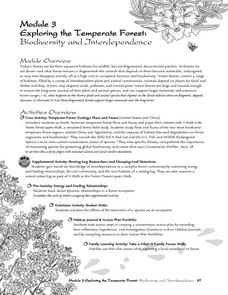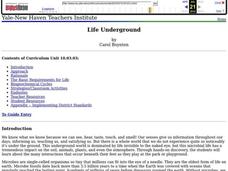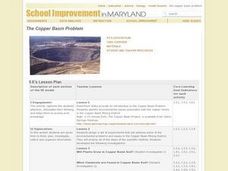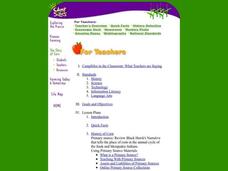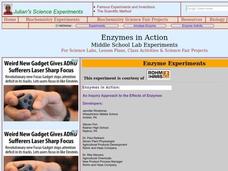Curated OER
Food's Altered Ego
Students write in their journals where they believe food comes from. After reading an article, they examine the proceses of cultivation and sale of genetically modified foods. Using the internet, they research specific countries and...
Curated OER
Web of Life - Role-Playing
Students role-play how organisms adapt to their environment. They play 20 questions with plant and animal habitats. They create a web of life to demonstrate how each plant and animal relies on the other for survival.
Curated OER
Make a Nature Mobile
Students take nature walks to collect items from the environment such as leaves, shells, branches, feathers, and seeds. Working in groups, they assemble their items into mobiles and display them in the classroom.
Curated OER
Exploring the Temperate Forest: Biodiversity and Interdependence
Students examine the consequences of cutting down large amounts of forests throughout the world. In groups, they use the internet to complete a module taking them on a tour through different temperate forests. To end the lesson, they...
Curated OER
Life Underground
First graders build a terrarium in order to observe animal and plant life dynamics. In this biology lesson plan, 1st graders compare how organisms survive in different environments. They write their observations and analysis in their...
Curated OER
Biomes and the water cycle
Students create a desert biome and a prairie biome and see how plants survive in both. For this biomes lesson plan, studnets create their biomes and see how the water cycle effect each biome and plant differently.
Curated OER
Can Photosynthesis Occur at Saturn?
Students identify the different requirements for photosynthesis to take place. In this space science instructional activity, students simulate conditions in Saturn to investigate if photosynthesis is possible there. They use data and...
Curated OER
Antebellum North Carolina
Eighth graders examine pictures & documents relating to the Hayes Plantation (Edenton, NC). They also use various maps of North Carolina to help them analyze how James Cathcart Johnston used, modified and adapted to the physical...
Curated OER
Yeast: A Dihybrid Cross
Students create a yeast dihybrid cross and follow two forms of each of two traits: red growth versus cream color, and tryptophan-dependent versus tryptophan-independent. They complete diagrams to represent the alleles, predict the...
Curated OER
Soil pH Effect on Germination of Specific Weeds
Students collect weed seeds from three varieties of weeds (knapweed, thistle, or toadflax, for example they may choose others in addition to the spotted knapweed.) They sterilize soil for thirty containers, plant seeds in sterile soil,...
Curated OER
What Goes Around Comes Around!
Students create an ecosystem in a jar to show a model of the water, carbon, and nitrogen cycle. Working in small groups, they research and present orally the information they find on this cycle.
Curated OER
The Copper Basin Problem
Students view a video about how human actions impact the environment. They design a set of experiments to address some of the problems and issues raised by the video.
Curated OER
Alphabet Letter a Or N Theme
Students draw a tree with acorns. They depict roots and an acorn in the soil to review plant growth and practice handwriting letter A or letter N in the writing lines. They cut an additional page for the mini-book to include the word...
Curated OER
Botanical Garden Field Trip
Young scholars take a field trip to a botanical garden. For this habitat lesson, students walk through the garden and see various species of plants and animals. Young scholars take a canopy walk and see coniferous trees. Students write...
Curated OER
Oklahoma Grown: Discovering Oklahoma's Agriculture
Fourth graders investigate where Oklahoma's variety of crops are harvested, and grown their own plants. A printable map and crop information guide are provided.
Curated OER
Function of a Stem
Fourth graders perform an experiment to test the function of a stem. In this science activity, 4th graders write a description of their investigations. Students also explain how the stem interacts with the rest of the plant. Students use...
Curated OER
The Story of Corn
Students use primary sources to compare the early development of corn with current techniques of biotechnology and genetically engineered seeds, and identify plants natural to the Americas and those natural to Europe that were part of...
Curated OER
Landforms
Learners study how landforms affect all aspects of a community. Students work in groups to identify landforms from other works of art. In cooperative groups Learners select a work of art depicting a particular land form and create a poem.
Curated OER
Fruit or Vegetable?
Watermelon is a vegetable? A tomato is a fruit? Believe it or not, this debate is decades old. Groups examine rulings by the US Supreme Court, the USDA, and state statutes before developing their own criteria to use when labeling the...
Curated OER
This I Can Do: The Drive
Learners read The Garden of Happiness and discuss the importance of the common good in a community. In this common good instructional activity, students understand how overcoming diversity and working together for a neighborhood drive....
Curated OER
Bats and Boas Abound
Students investigate Puerto Rican boa constrictors and bats. For this animal science lesson, students read an article about the bats and snakes found in Puerto Rico. Students use various art supplies to create a diorama of the habitat of...
Curated OER
Food Chain: what's for dinner?
Fourth graders identify where foods came from and sequence a food chain. In this food chain lesson, 4th graders define vocabulary related to food chains and order a food chain. Students follow the energy of a food chain. Students...
Curated OER
Lesson 12: Ho'olaulima: Let's Make a Hawaiian Garden
Second graders grow a classroom garden that acts as a living laboratory for cross-curricular activities. In this classroom garden lesson, 2nd graders follow directions to build and plant a garden that is used to teach math, science, and...
Curated OER
Enzymes in Action
Young scholars explore how enzymes are important in the chemical reactions of all living things. In this enzymes and catalysts lesson students complete an activity to see how enzymes change living things.





